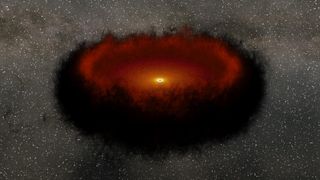Black holes may be swallowing invisible matter that slows the movement of stars
Scientists watched as two stars slowed in their orbits around black holes, concluding it was the result of "drag" generated by dark matter.

For the first time, scientists may have discovered indirect evidence that large amounts of invisible dark matter surround black holes. The discovery, if confirmed, could represent a major breakthrough in dark matter research.
Dark matter makes up around 85% of all matter in the universe, but it is almost completely invisible to astronomers. This is because, unlike the matter that comprises stars, planets and everything else around us, dark matter doesn't interact with light and can't be seen.
Fortunately, dark matter does interact gravitationally, enabling researchers to infer the presence of dark matter by looking at its gravitational effects on ordinary matter "proxies." In the new research, a team of scientists from The Education University of Hong Kong (EdUHK) used stars orbiting black holes in binary systems as these proxies.
Related: What's the biggest black hole in the universe?
The team watched as the orbits of two stars decayed, or slightly slowed, by about 1 millisecond per year while moving around their companion black holes, designated A0620–00 and XTE J1118+480. The team concluded that the slow-down was the result of dark matter surrounding the black holes which generated significant friction and a drag on the stars as they whipped around their high-mass partners.
Using computer simulations of the black hole systems, the team applied a widely held model in cosmology called the dark matter dynamical friction model, which predicts a specific loss of momentum on objects interacting gravitationally with dark matter. The simulations revealed that the observed rates of orbital decay matched the predictions of the friction model. The observed rate of orbital decay is around 50 times greater than the theoretical estimation of about 0.02 milliseconds of orbital decay per year for binary systems lacking dark matter.
"This is the first-ever study to apply the 'dynamical friction model' in an effort to validate and prove the existence of dark matter surrounding black holes," Chan Man Ho, the team leader and an associate professor in the Department of Science and Environmental Studies at EdUHK, said in a statement.
The team's results, published Jan. 30 in The Astrophysical Journal Letters, help to confirm a long-held theory in cosmology that black holes can swallow dark matter that comes close enough to them. This results in the dark matter being redistributed around the black holes, creating a "density spike" in their immediate vicinity that can subtly influence the orbit of surrounding objects.
Chan explained that previous attempts to study dark matter around black holes have relied on the emission of high-energy light in the form of gamma rays, or ripples in space known as gravitational waves. These emissions result from the collision and resulting merger of black holes – a rare event in the universe that can leave astronomers waiting a long time for sufficient data.
This research gives scientists a new way to study dark matter distributed around black holes that may help them to be more proactive in their search. The EdUHK team intends to hunt for similar black hole binary systems to study in the future.
"The study provides an important new direction for future dark matter research," Chan said. "In the Milky Way Galaxy alone, there are at least 18 binary systems akin to our research subjects, which can provide rich information to help unravel the mystery of dark matter."
Sign up for the Live Science daily newsletter now
Get the world’s most fascinating discoveries delivered straight to your inbox.
Robert Lea is a science journalist in the U.K. who specializes in science, space, physics, astronomy, astrophysics, cosmology, quantum mechanics and technology. Rob's articles have been published in Physics World, New Scientist, Astronomy Magazine, All About Space and ZME Science. He also writes about science communication for Elsevier and the European Journal of Physics. Rob holds a bachelor of science degree in physics and astronomy from the U.K.’s Open University
-
jgfernald Dark matter. Can a comet be composed of dark matter? If it can, what happens if earth gets hit by a dark matter comet? Is it the same as when a "regular" comet collides?Reply -
bolide2 Reply
The things that hit the Earth are asteroids, not comets. So the better question would be, Can an asteroid be composed of dark matter? And if so ...jgfernald said:Dark matter. Can a comet be composed of dark matter? If it can, what happens if earth gets hit by a dark matter comet? Is it the same as when a "regular" comet collides?
I think the answer given would be No. For one thing, dark matter can't "hit" regular matter (come into physical contact), because it doesn't interact with regular matter at all, except gravitationally. That still leaves the question whether dark matter could form clumps, like regular matter does, as in asteroids, or planets. And if not, why not? Does dark matter gravitationally attract itself? Do we need another word for this, rather than "matter"? -
ja4nice It seems to me that Black Holes are simply drains to equalize the space which was begun with the Big Bang. Naturally occurring there's one big one at the heart of each galaxy.Reply
Most Popular

By Deepa Jain

By Tom Metcalfe

By Deepa Jain
